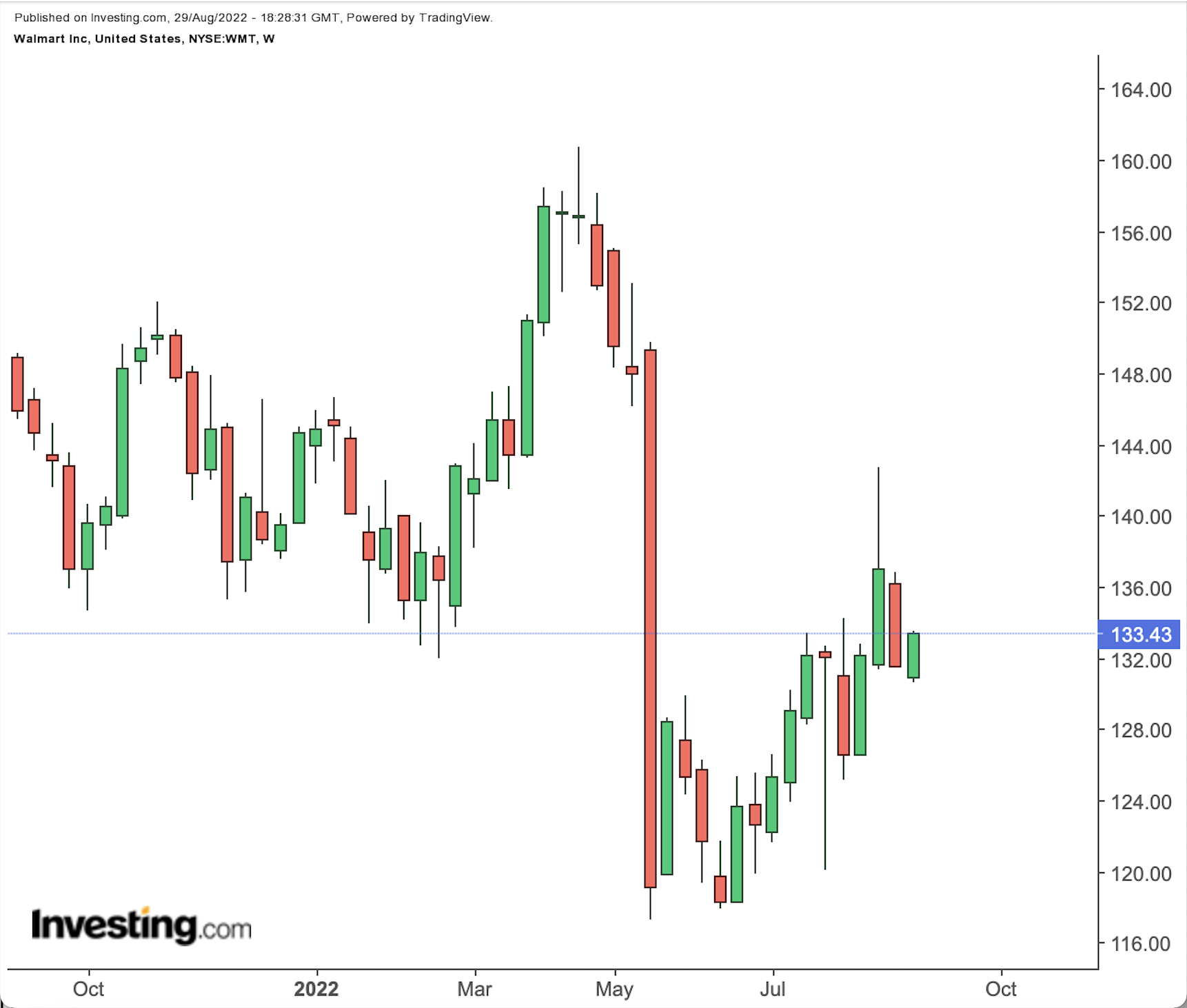United Homes Group stock plunges after Nikki Haley, directors resign
- Walmart’s performance this year shows a resilient business managing through a difficult period
- E-commerce and grocery segments are performing well, and the retail giant will work through inventory issues
- But valuation mostly reflects the good news: WMT is a solid pick here, but would be compelling at a better price
A funny thing has happened to Walmart (NYSE:WMT) stock over the past two years: nothing. In the last 24 months, Walmart stock actually has declined 6.4%.

Source: Investing.com
We’ve been here before. It’s easy to forget, but Walmart struggled during the last decade — at least by its lofty standards. Same-store sales stalled out, rival Amazon.com (NASDAQ:AMZN) was making clear inroads, and even the grocery business appeared stagnant. From the beginning of 2013 to the beginning of 2017, WMT stock gained 1.3% — total. The S&P 500 rose 57% over the same stretch.
But then Walmart got its act together, notably on the e-commerce front. WMT stock became a big winner, more than doubling in less than four years.
It seems likely that at some point, this period of stagnation, too, will be followed by solid returns. The pressures on Walmart shares and on Walmart profits largely are coming from external sources. As this month’s second-quarter earnings shows, the company actually is managing rather well through those pressures, and indeed through a time perhaps unprecedented in the company’s 60-year history.
The one catch as far as WMT stock goes is that, at least for now, the market still is giving the company credit for that resilience. WMT looks like a solid pick in a turbulent market, but it might be a better choice if that turbulence results in a more attractive entry point.
Walmart Hangs In
At first blush, neither the results in Walmart’s fiscal second quarter nor its outlook for the rest of the year seem particularly inspiring.
In Q2, same-store sales increased 6.5% year-over-year — but with inflation running at a similar level, that top-line performance looks relatively unimpressive. Q3 guidance for just a 3% rise — growth that would fall well below current inflation — looks even worse.
Walmart’s earnings for the quarter did top analyst expectations, and its full-year outlook is better than the company warned it would be a month ahead of the release. But in both cases, a pair of small one-time effects boosted earnings (the effects were kept in the calculation of adjusted earnings), and Walmart still projects an 8% to 10% year-over-year decline in adjusted earnings per share.
But in the context of the external environment, that performance actually looks pretty good. Inflation, of course, is a major headwind for U.S. retailers, but it’s not the only one. Huge demand in 2021 — thanks to flush consumer balance sheets and still-limited entertainment options outside the home — turned into ballooning inventories in 2022. That, in turn, forced companies like Walmart and Target (NYSE:TGT) to discount heavily simply to get product out the door.
Given the effects of inflation and the pandemic response on consumer behavior, a high-single-digit decline in EPS appears rather strong. Target, for instance, likely will see its EPS plunge 40% this year. Many smaller retailers have reversed from strong 2021 profits to reasonably large 2022 losses.
And, notably, outside of the inventory problems — mostly in apparel — Walmart still is chugging along. In the grocery sector, the company took incremental market share in Q2, according to the Walmart earnings release. Walmart U.S. eCommerce revenues grew 12%, a rather impressive performance in this retail environment; Amazon’s North America business only grew sales 10%.
On a three-year basis (in other words, comparing to pre-pandemic levels), Amazon in Q2 almost doubled its revenue in North America, but U.S. Walmart’s e-commerce business is up in the range of 130%.
Is WMT Stock Too Expensive?
There’s essentially no evidence that, as a business, Walmart has lost its edge. It’s taking share in grocery. It’s outperforming Target. It’s keeping pace, at least, with Amazon. In the context of owning WMT stock long term, this year’s performance could be seen in a quite optimistic light. Given the external environment, it could be much, much worse. As noted, for most retailers, in fact, it is much, much worse.
The concern is valuation. That seems perhaps a strange thing to say for a stock that hasn’t moved in two years, and trades 17% below its highs. But Walmart’s guidance implies adjusted EPS below $6 this year, and a price-to-earnings multiple of around 22x.
For Walmart, that’s a reasonably big valuation. At the beginning of 2020, for instance, shares traded at 23x FY20 EPS — and that was near the highest level in more than a decade. More generally, a 22x earnings multiple prices in a relatively quick return to growth, and limited impact from further inflation and/or a recessionary environment.
That seems a reasonable scenario, certainly. Walmart management noted after Q2 that inflation already had led some higher-income shoppers into its stores. In fiscal 2010, during the worst of the financial crisis, Walmart’s U.S. same-store sales declined less than 1%. Inventory will be normalized come the beginning of this year, and again there’s no evidence that Walmart’s execution or competitive position have weakened.
Walmart probably will fight through this patch and come out on the other side. At the same time, however, that’s precisely what the market is pricing into the stock, making it difficult to see the current valuation as truly compelling. This is a great business, and in the context of retail valuations, the market is pricing it essentially as such. While that remains the case, WMT stock is interesting. Should investors panic and offer a lower entry point, it’s then the stock gets compelling.
Disclaimer: As of this writing, Vince Martin has no positions in any securities mentioned.
